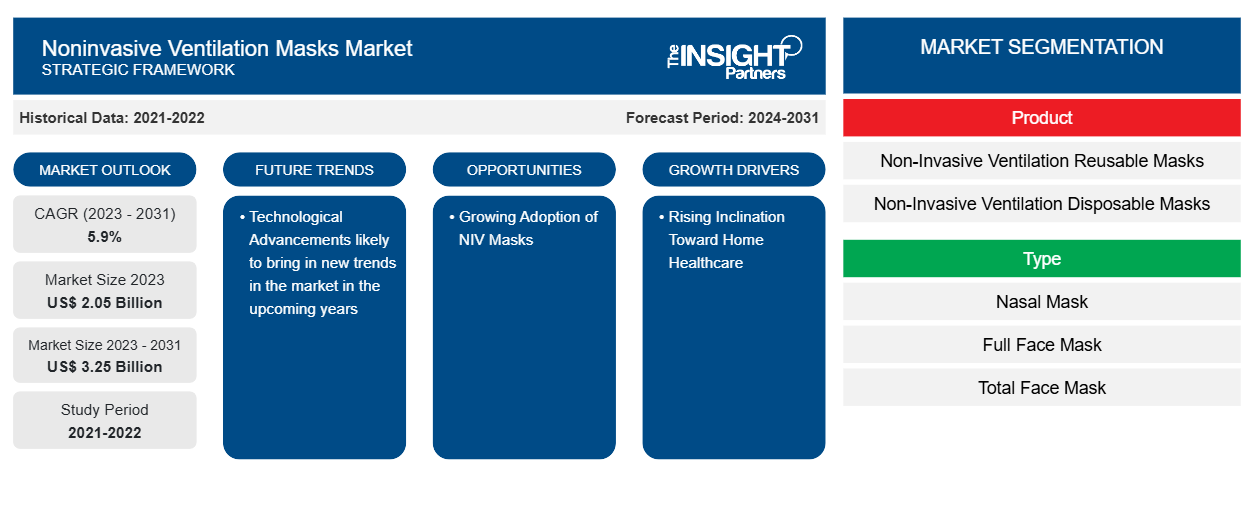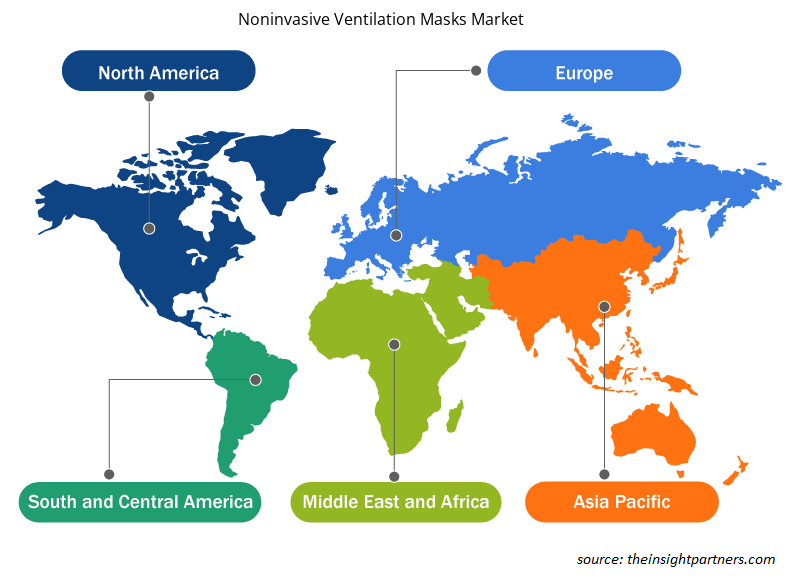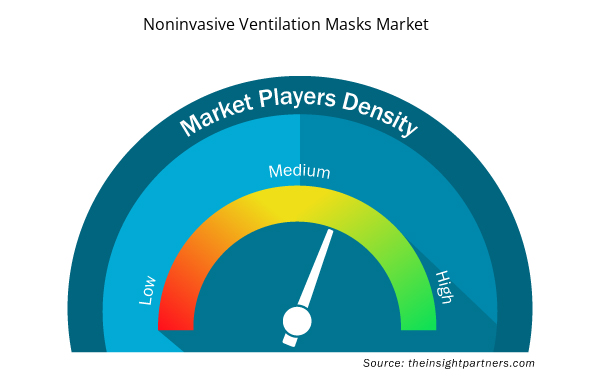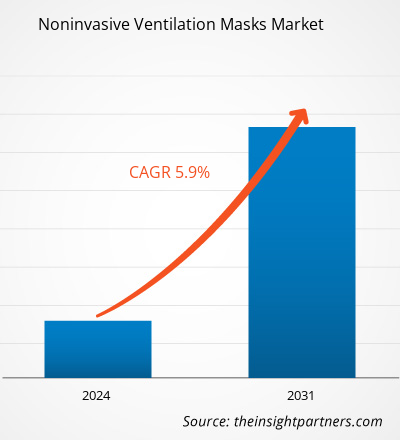The noninvasive ventilation masks market size is projected to reach US$ 3.25 billion by 2031 from US$ 2.05 billion in 2023. The market is expected to register a CAGR of 5.9% during 2023–2031. The rising technological advancements in noninvasive ventilation masks are likely to act as a future trend in the market in the coming years.
Noninvasive Ventilation Masks Market Analysis
Invasive ventilation methods are often avoided in COPD patients to reduce risks of complications such as infections and mechanical lung injuries. Noninvasive ventilation masks are preferred because they provide breathing support without requiring intubation. Thus, the chronic, long-term nature of COPD and sleep apnea leads to repeat purchases and creates a demand for NIV masks, thereby generating a steady, sustainable market for manufacturers.
Noninvasive Ventilation Masks Market Overview
According to the National Council on Aging, Inc. estimates, 39 million adults in the US had OSA in 2023. As per an article titled "What knows a frail Swiss population about chronic obstructive pulmonary disease?," about 400,000 people in Switzerland suffered from COPD in 2021. Noninvasive ventilation (NIV) is the administration of oxygen support through a face mask, eliminating the need for an endotracheal airway in the treatment of various conditions, including COPD, cardiogenic pulmonary edema, and other respiratory conditions without complications such as respiratory muscle weakness, upper airway trauma, and ventilator-associated pneumonia. Noninvasive ventilation masks can be reusable or disposable. The disposable noninvasive ventilation masks are for single use and are disposed off to reduce the risk of cross-contamination. Advances in mask design, comfort, durability, and the incorporation of skin-friendly materials can boost the adoption of NIV masks as patients look for more efficient and comfortable products. Thus, the adoption of NIV masks as an effective treatment of such prevalent respiratory conditions is expected to continue to boost the growth of the noninvasive ventilation masks market during 2023–2031.
Customize This Report To Suit Your Requirement
You will get customization on any report - free of charge - including parts of this report, or country-level analysis, Excel Data pack, as well as avail great offers and discounts for start-ups & universities
Noninvasive Ventilation Masks Market: Strategic Insights

- Get Top Key Market Trends of this report.This FREE sample will include data analysis, ranging from market trends to estimates and forecasts.
You will get customization on any report - free of charge - including parts of this report, or country-level analysis, Excel Data pack, as well as avail great offers and discounts for start-ups & universities
Noninvasive Ventilation Masks Market: Strategic Insights

- Get Top Key Market Trends of this report.This FREE sample will include data analysis, ranging from market trends to estimates and forecasts.
Noninvasive Ventilation Masks Market Drivers and Opportunities
Rising Inclination Toward Home Healthcare Fuels Market
A shift from long-term facilities, inpatient rehabilitation, and skilled nursing facilities to home care settings results in a better, consistent, and timely interaction between patient and doctor owing to the cloud and mobility-driven medical devices. The COVID-19 outbreak triggered home healthcare's importance due to limited hospital bed capacity and a scarcity of skilled healthcare professionals. With the help of home healthcare, healthcare professionals can monitor patient's vitals remotely and avoid hospital admissions.
Moreover, patients with conditions such as COPD, sleep apnea, and other respiratory issues are increasingly expressing a preference for at-home management of their ailments. Patients can use NIV therapy in the comfort of their homes without having to make frequent visits to the hospital. Home healthcare providers are prescribing NIV masks more frequently as a component of all-encompassing respiratory care plans.
Therefore, due to the growing traction toward home healthcare and increasing demand for more advanced, affordable, and easily navigable devices at home, the market for Noninvasive ventilation masks is gaining noticeable traction.
Growing Adoption of NIV Masks to Offer Opportunities for Market
Noninvasive ventilation masks are becoming increasingly popular and expanding market opportunities by spurring innovation. Earlier diagnosis and treatment are being made possible by growing awareness campaigns about respiratory disorders such as COPD, sleep apnea, and others. The increased prescription and usage of NIV masks for disease management results from greater awareness among patients and healthcare professionals. Thus, emerging awareness of early diagnosis is likely to drive the adoption of NIV masks and create significant opportunities in the market. Moreover, respiratory illnesses are becoming more common in emerging economies, particularly in Asia Pacific, Latin America, and the Middle East, due to pollution, urbanization, and lifestyle changes. The noninvasive therapies are becoming widely known in these areas, owing to which the use of NIV masks is likely to continue to propel during the forecast period.
Noninvasive Ventilation Masks Market Report Segmentation Analysis
Key segments that contributed to the derivation of the noninvasive ventilation masks market analysis are product, application, and end user.
- Based on product, the noninvasive ventilation masks market is bifurcated into noninvasive ventilation disposable mask and noninvasive ventilation reusable mask. The noninvasive ventilation disposable mask segment held a larger share of the noninvasive ventilation masks market in 2023.
- Based on application, the market is segmented into obstructive sleep apnea, chronic obstructive pulmonary disease, pneumonia, and others. The sleep apnea segment held the largest share of the noninvasive ventilation masks market in 2023.
- Based on end user, the market is segmented into hospitals and clinics, homecare, and others. The hospitals and clinics segment held the largest share of the noninvasive ventilation masks market in 2023.
Noninvasive Ventilation Masks Market Share Analysis by Geography
The geographic scope of the noninvasive ventilation masks market report is mainly divided into five regions: North America, Asia Pacific, Europe, South & Central America, and the Middle East & Africa. North America dominated the market in 2023. The US is the largest and fastest-growing market for noninvasive ventilation masks. According to the American Medical Association, ~30 million people in the US had sleep apnea in 2022; however, only 6 million were screened for this condition. In addition, ~14.8 million adults have been diagnosed with COPD in the same year, which is the fourth leading cause of death in the US. The growing prevalence of these chronic lung diseases is expected to increase the demand for NIV treatment options, boosting the growth of the noninvasive ventilation masks market in the US.
Furthermore, the presence of leading market players, such as Sleepnet Corporation, Philips, and Hamilton Medical, offering NIV masks and strategic developments by these market players in the US are expected to increase the noninvasive ventilation masks market share in the country during the forecast period. For instance, in August 2024, Sleepnet Corporation partnered with a renowned US pediatric hospital to introduce the Mini Me 2 NIV mask for studying the impact of innovative medical devices on patient care.
Noninvasive Ventilation Masks Market Regional Insights
The regional trends and factors influencing the Noninvasive Ventilation Masks Market throughout the forecast period have been thoroughly explained by the analysts at Insight Partners. This section also discusses Noninvasive Ventilation Masks Market segments and geography across North America, Europe, Asia Pacific, Middle East and Africa, and South and Central America.

- Get the Regional Specific Data for Noninvasive Ventilation Masks Market
Noninvasive Ventilation Masks Market Report Scope
| Report Attribute | Details |
|---|---|
| Market size in 2023 | US$ 2.05 Billion |
| Market Size by 2031 | US$ 3.25 Billion |
| Global CAGR (2023 - 2031) | 5.9% |
| Historical Data | 2021-2022 |
| Forecast period | 2024-2031 |
| Segments Covered |
By Product
|
| Regions and Countries Covered | North America
|
| Market leaders and key company profiles |
Noninvasive Ventilation Masks Market Players Density: Understanding Its Impact on Business Dynamics
The Noninvasive Ventilation Masks Market is growing rapidly, driven by increasing end-user demand due to factors such as evolving consumer preferences, technological advancements, and greater awareness of the product's benefits. As demand rises, businesses are expanding their offerings, innovating to meet consumer needs, and capitalizing on emerging trends, which further fuels market growth.
Market players density refers to the distribution of firms or companies operating within a particular market or industry. It indicates how many competitors (market players) are present in a given market space relative to its size or total market value.
Major Companies operating in the Noninvasive Ventilation Masks Market are:
- Hamilton Medical AG,
- ResMed Inc,
- Fisher & Paykel Healthcare Corp Ltd,
- Air Liquide Medical Systems,
- Dragerwerk AG & Co KGaA,
Disclaimer: The companies listed above are not ranked in any particular order.

- Get the Noninvasive Ventilation Masks Market top key players overview
Noninvasive Ventilation Masks Market News and Recent Developments
The noninvasive ventilation masks market is evaluated by gathering qualitative and quantitative data post primary and secondary research, which includes important corporate publications, association data, and databases. A few of the developments in the market are listed below:
- SunMed acquired respiratory and anesthesia consumables business of Vyaire Medical. This acquisition combined the strengths of both companies to enhance innovation, ensure reliable product supply, and provide high-quality medical products for better patient outcomes. [Source: SunMed Group Holdings LLC (AirLife), Company Website, March 2023].
- Intersurgical acquired Pulmodyne, a USA and Malaysia-based manufacturer specializing in airway and respiratory products. The acquisition will expand Intersurgical's product range, strengthen its presence in the US market, and increase sales of Pulmodyne products globally. (Source: ICU Medical, Company Website, January 2022)
Noninvasive Ventilation Masks Market Report Coverage and Deliverables
The "Noninvasive Ventilation Masks Market Size and Forecast (2021–2031)" report provides a detailed analysis of the market covering below areas:
- Noninvasive ventilation masks market size and forecast at global, regional, and country levels for all the key market segments covered under the scope
- Noninvasive ventilation masks market trends, as well as market dynamics such as drivers, restraints, and key opportunities
- Detailed PEST and SWOT analysis
- Noninvasive ventilation masks market analysis covering key market trends, global and regional framework, major players, regulations, and recent market developments
- Industry landscape and competition analysis covering market concentration, heat map analysis, prominent players, and recent developments for the noninvasive ventilation masks market
- Detailed company profiles
- Historical Analysis (2 Years), Base Year, Forecast (7 Years) with CAGR
- PEST and SWOT Analysis
- Market Size Value / Volume - Global, Regional, Country
- Industry and Competitive Landscape
- Excel Dataset



Report Coverage
Revenue forecast, Company Analysis, Industry landscape, Growth factors, and Trends

Segment Covered
Product, Type, Application, End User, and Geography

Regional Scope
North America, Europe, Asia Pacific, Middle East & Africa, South & Central America

Country Scope
Argentina, Australia, Benelux, Brazil, Canada, China, France, Germany, India, Indonesia, Italy, Japan, Malaysia, Mexico, Saudi Arabia, Singapore, South Africa, South Korea, Spain, Thailand, Turkey, United Arab Emirates, United Kingdom, United States
Frequently Asked Questions
What is the expected CAGR of the noninvasive ventilation masks market?
The market is expected to register a CAGR of 5.9% during 2023–2031.
Which region dominated the noninvasive ventilation masks market in 2023?
North America dominated the market in 2023.
What would be the estimated value of the noninvasive ventilation masks market by 2031?
The noninvasive ventilation masks market value is expected to reach US$ 3.25 billion by 2031.
What are the factors driving the noninvasive ventilation masks market growth?
The increasing prevalence of respiratory diseases and the growing inclination toward home healthcare are among the most significant factors fueling the market growth.
Who are the leading players operating in the noninvasive ventilation masks market?
Hamilton Medical AG, ResMed Inc, Fisher & Paykel Healthcare Corp Ltd, Air Liquide Medical Systems, Dragerwerk AG & Co KGaA, Intersurgical Ltd, BMC Medical Co Ltd, DeVilbiss Healthcare LLC, Armstrong Medical Ltd, Koninklijke Philips NV, Besmed Health Business Corp, Sleepnet Corporation, SunMed Group Holdings LLC (AirLife), Dimar S.P.A., and Hangzhou Formed Medical Devices Co., Ltd are among the key players in the market.
What are the future trends of the noninvasive ventilation masks market?
Technological advancements in noninvasive ventilation masks are expected to emerge as a prime trend in the market in the coming years.
Trends and growth analysis reports related to Life Sciences : READ MORE..
The List of Companies - Noninvasive Ventilation Masks Market
- Hamilton Medical AG
- ResMed Inc
- Fisher & Paykel Healthcare Corp Ltd
- Air Liquide Medical Systems,
- Dragerwerk AG & Co KGaA,
- Intersurgical Ltd
- BMC Medical Co Ltd
- DeVilbiss Healthcare LLC
- Armstrong Medical Ltd
- Koninklijke Philips NV
- Besmed Health Business Corp
- Sleepnet Corporation
- SunMed Group Holdings LLC (AirLife)
- Dimar S.P.A.
- Hangzhou Formed Medical Devices Co., Ltd

 Get Free Sample For
Get Free Sample For